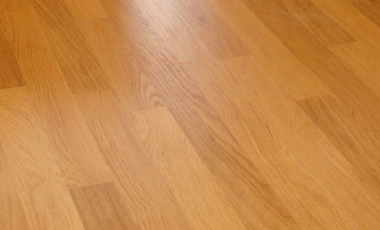 Laminate flooring is an interlocking flooring system that uses the tongue and groove method of joining the individual planks. It is installed as a “floating floor.” A layer of foam is placed under the flooring and the individual “boards” are glued together or clipped together using one of several dry joint methods. The individual pieces of laminate flooring are not glued or nailed down to the sub-floor. Laminate flooring can be installed over concrete, plywood, or OSB sub-flooring. And while other forms of flooring may not be suited for some types of existing floor, laminate can be applied directly over ceramic tile, vinyl, and parquet floors.
Laminate flooring is an interlocking flooring system that uses the tongue and groove method of joining the individual planks. It is installed as a “floating floor.” A layer of foam is placed under the flooring and the individual “boards” are glued together or clipped together using one of several dry joint methods. The individual pieces of laminate flooring are not glued or nailed down to the sub-floor. Laminate flooring can be installed over concrete, plywood, or OSB sub-flooring. And while other forms of flooring may not be suited for some types of existing floor, laminate can be applied directly over ceramic tile, vinyl, and parquet floors.
When installing a laminate floor, it should be at the same height as adjoining floors. Laminate floors pieces consist of 3 layers, a “wearlayer” comprising a melamine resin for durability, wear and stain resistance (made from aluminum oxide), a “print layer” which is a photograph of a real floor; and a backing board where the wearlayer and print layer sits on. The pieces are installed an underlay (see below for types of underlay needed for different sub-floors) over a level, no bounce sub-floor. Typically the floor should be sound and flat with no voids greater than 3 inches. High spots must be ground off and low spots filled to make the floor flat. To allow for any movement of the floor, a 10mm expansion gap around the perimeter of the room is needed. You can use spacers/wedges (included in standard installation kits purchased separately). If the floor is touching or too close to a wall, it will undoubtedly fail. After the floor has been installed, cover this expansion gap with scotia / beading or new skirting boards. The 10mm expansion gap also needs to be left in doorways where the floor follows through from one room to another.
Tip : When installing over a concrete sub-floor an underlay which has a built in damp proof membrane will be needed (overlap the edges 4 inches. Tape all seams together using duct tape), while over a wooden sub-floor you can use a standard underlay (without overlappings). For other floors, lay the foam underlayment in the same direction.
What you need
1. Laminated flooring pieces with tongue and grove construction; simply snap and click pieces together;
2. Hammer;
3. Tapping block – nylon or plastic block that matches the tongue and groove of the flooring that allows you to tap flooring together without damaging the pieces;
4. Metal pullbar for use up against a wall slide next to wall and allows you to tap (with hammer) the pieces together when they are aligned wall to wall;
5. Fitting wedges/spacer – To align the flooring evenly when placed against wall
6. Circular saw with a fine tooth blade or a jig saw and power saw for cutting the pieces. When cutting a laminate floor piece always cut “wearlayer” side down, to reduce tear out on the cuts.
The tapping block, metal pullbar and fitting wedges/spacer normally comes in an installation kit. All these items can be bought at wholesale construction material.
Installing the Laminate Flooring
Prep the floor by removing baseboards and moldings around the room and any doors in the room. Fasten down loose or squeaking floorboards and level the floor of dips. Install the underlay foam against each other (not overlapping) and tape the seams with duct tape. Place a plastic sheet if the laminate is being placed directly over a concrete floor. Doorframes may need to be modified with the new height of the laminate flooring. Starting at the far side of the room, measure across the room to determine out if there is a need to rip the first plank. Installation should end up with the pieces on both sides of the room at approximately the same width. Lay the first boards against the starting wall, groove side towards the wall. If there is a need to rip the first row of boards to width, cut off the groove side. Use spacers/wedges to ensure a 10 mm gap between the flooring and the wall. Lay the first board in the first row which is a FULL BOARD. The first board in the second row should be 2/3 of a board and the first board in the third row should be 1/3 of a board. This will give a STAGGARD PATTERN flow in installation. Fill in the rows with full boards and boards cut to fit the remaining space. Repeat the pattern across the room, ensuring that joints are always at least 8″ from each other. Join the boards together and tap gently with a hammer and the tapping block to make sure the boards lock together.
When working close to the wall, use the pry bar to pull the boards into place end to end. When all floorboards are installed, reinstall baseboards and moldings nailing them to the wall and not the laminate flooring to cover the 10 mm gap left around the perimeter of the room.
Note : After laying laminate flooring Wait 24 hours after installing a laminate floor before walking or moving furniture back in. Remove spacers/wedges and cover any expansion spaces. Matching and color-coordinated trim can be obtained from the flooring manufacturer. Mouldings should be installed with pegs or screws, do not fasten down the flooring planks with the trim as this would prevent the floating laminate surface from moving freely.
Note : Caring for Laminate Flooring
Laminate flooring is not only hygienic but also very easy to look after. Below are some maintenance tips to prolong your laminate flooring and increase durability:
- Dry floor needs to be swept with a soft broom or use a vacuum cleaner.
- Wipe off marks and dirt with a slightly damp cloth, following the grain of the plank. Use laminate cleaner for stubborn stains.
- Use felt pads under furniture and soft rubber castors on chairs (which can be bought from hardware stores).
- Place door mats in special areas (hall, entrance). In industrial buildings, provide footwells.
- Repair minor damage with the laminate repair kit. Consult a specialist in the case of a more serious damage.

